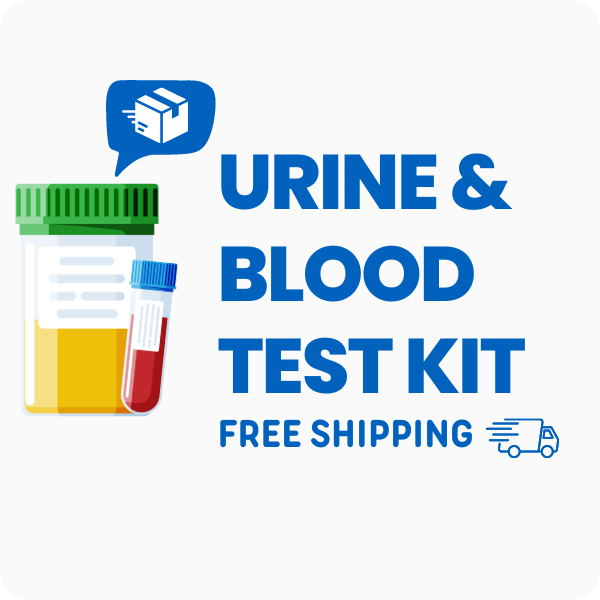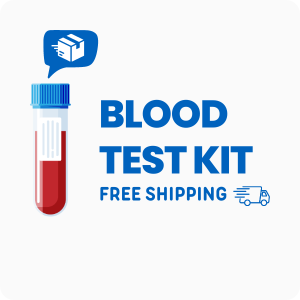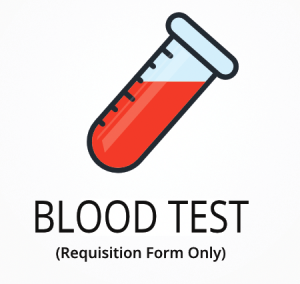Ordering the NutrEval Amino Acids in Plasma Genova Test
The NutrEval Amino Acids in Plasma Genova test measures amino acids in the blood to help identify nutrient imbalances that may affect energy, mood, metabolism, and muscle function. This test can help pinpoint specific amino acid deficiencies or excesses that may contribute to symptoms like fatigue, brain fog, mood swings, and muscle weakness. Interestingly, this test can also reveal hidden metabolic issues that may not show up on standard blood panels, offering a more detailed look at how your body processes nutrients.
Ordering this test provides several specific benefits:
- Detects amino acid imbalances that may affect energy, focus, and muscle strength
- Assesses nutrient status related to metabolism, mood, and immune function
- Identifies possible links between nutrient deficiencies and symptoms like hair loss or skin changes
- Helps guide targeted nutrition or supplement plans based on your unique needs
- Monitors the impact of dietary changes or supplement use over time
Who Should Consider Comprehensive Amino Acid and Nutrient Testing
People who experience ongoing tiredness, trouble concentrating, or frequent mood changes may benefit from this test. For example, someone who feels drained after a full night’s sleep and struggles with memory or focus at work could use this test to check for nutrient imbalances that might be affecting their energy and brain function.
Ordering this test may also be helpful in these situations:
- Persistent digestive issues that do not improve with diet changes
- Unexplained muscle weakness or joint pain
- Sudden changes in hair or nail strength
- Difficulty managing weight despite regular exercise and healthy eating
- Frequent colds or infections, which may be linked to nutrient status
Testing for amino acid and nutrient levels can help identify specific imbalances that may be linked to symptoms like fatigue, poor concentration, or slow recovery from exercise. Delaying this test could mean missing the chance to address these issues early, which may lead to longer periods of low energy or ongoing symptoms. To move forward, consider ordering the test to get a clearer picture of your nutrient status.
How to Prepare for the Test
Fasting for 8 hours is required before collecting your blood sample for the NutrEval Amino Acids in Plasma Genova test. Always follow any instructions provided by your doctor or healthcare practitioner to make sure your sample is collected correctly and your results are as useful as possible.
Labs Included When Ordering Your NutrEval Amino Acids in Plasma Genova Test
| Test Name | Reference Range | Significance | Low and High Levels of NutrEval Amino Acids in Plasma Genova |
|---|---|---|---|
| Amino Acid Analysis | |||
| Alanine | 210-430 | Alanine is involved in energy production and helps remove toxins from muscle tissue. It supports glucose metabolism and muscle health. | High levels mean possible muscle breakdown or liver issues.
Low levels mean reduced energy production or poor protein intake. |
| Arginine | 50-120 | Arginine supports blood flow, immune response, and wound healing. It is also important for hormone release and detoxification. | High levels mean increased protein breakdown or metabolic stress.
Low levels mean impaired healing or immune function. |
| Asparagine | 35-80 | Asparagine helps with nerve function and is needed for protein synthesis. It also supports brain and muscle health. | High levels mean possible kidney issues or high protein breakdown.
Low levels mean poor protein intake or absorption. |
| Aspartic Acid | 2-10 | Aspartic acid is involved in energy cycles and helps with hormone production. It is important for brain and muscle function. | High levels mean increased protein breakdown or metabolic stress.
Low levels mean reduced energy production or poor diet. |
| Citrulline | 15-55 | Citrulline helps remove ammonia from the body and supports blood flow. It is also important for energy and muscle recovery. | High levels mean possible liver or kidney dysfunction.
Low levels mean reduced detoxification or poor protein intake. |
| Glutamine | 400-900 | Glutamine is the most abundant amino acid in the blood and supports gut, brain, and immune function. It is also needed for muscle repair. | High levels mean stress, trauma, or infection.
Low levels mean poor gut health or muscle loss. |
| Glycine | 150-400 | Glycine helps with detoxification, sleep, and collagen production. It is also important for brain and muscle function. | High levels mean possible metabolic or kidney issues.
Low levels mean poor protein intake or sleep problems. |
| Histidine | 60-120 | Histidine is needed for growth, tissue repair, and making histamine. It also supports immune and digestive function. | High levels mean increased protein breakdown or inflammation.
Low levels mean poor healing or low stomach acid. |
| Isoleucine | 40-90 | Isoleucine is a branched-chain amino acid important for muscle repair, energy, and blood sugar control. | High levels mean muscle breakdown or metabolic stress.
Low levels mean muscle weakness or fatigue. |
| Leucine | 80-170 | Leucine is a branched-chain amino acid that supports muscle growth, energy, and tissue repair. | High levels mean muscle breakdown or metabolic issues.
Low levels mean muscle loss or poor recovery. |
| Lysine | 100-220 | Lysine is needed for growth, tissue repair, and making hormones and enzymes. It also supports immune function. | High levels mean kidney issues or high protein intake.
Low levels mean poor healing or frequent infections. |
| Methionine | 15-40 | Methionine is important for detoxification, making proteins, and supporting liver health. | High levels mean possible liver or metabolic issues.
Low levels mean poor detoxification or low protein intake. |
| Phenylalanine | 40-80 | Phenylalanine is needed for making neurotransmitters and supports mood, focus, and memory. | High levels mean metabolic disorders or liver issues.
Low levels mean mood changes or poor focus. |
| Proline | 90-250 | Proline is important for collagen production, skin health, and joint function. | High levels mean possible kidney or metabolic issues.
Low levels mean poor skin or joint health. |
| Serine | 70-180 | Serine supports brain function, mood, and metabolism. It is also needed for making proteins and cell membranes. | High levels mean metabolic stress or kidney issues.
Low levels mean poor memory or mood changes. |
| Threonine | 40-110 | Threonine is needed for making proteins, collagen, and supports gut and immune health. | High levels mean metabolic or kidney issues.
Low levels mean poor gut or immune function. |
| Tryptophan | 20-60 | Tryptophan is needed for making serotonin, which affects mood, sleep, and stress response. | High levels mean metabolic or liver issues.
Low levels mean mood swings, sleep problems, or anxiety. |
| Tyrosine | 40-90 | Tyrosine is needed for making dopamine and thyroid hormones, supporting mood, focus, and metabolism. | High levels mean metabolic or thyroid issues.
Low levels mean low energy, poor focus, or mood changes. |
| Valine | 120-240 | Valine is a branched-chain amino acid that supports muscle growth, energy, and tissue repair. | High levels mean muscle breakdown or metabolic stress.
Low levels mean muscle weakness or fatigue. |
| Fatty Acids and Metabolic Markers | |||
| Omega-3 Fatty Acids | 4-8% | Omega-3s support brain, heart, and joint health. They help reduce inflammation and support mood balance. | High levels mean excess supplementation.
Low levels mean increased inflammation or mood changes. |
| Omega-6 Fatty Acids | 15-30% | Omega-6s are needed for cell structure and hormone production. Balance with omega-3s is important for reducing inflammation. | High levels mean increased inflammation.
Low levels mean poor cell function or hormone imbalance. |
| Saturated Fatty Acids | 30-40% | Saturated fats are needed for cell membranes and hormone production. Too much can increase risk for heart issues. | High levels mean increased risk for heart problems.
Low levels mean poor cell structure or hormone production. |
| Minerals and Heavy Metals | |||
| Magnesium | 1.6-2.6 | Magnesium supports muscle, nerve, and bone health. It is also important for energy production and stress response. | High levels mean kidney issues or excess supplementation.
Low levels mean muscle cramps, fatigue, or sleep problems. |
| Zinc | 70-120 | Zinc is needed for immune function, wound healing, and hormone production. It also supports skin and hair health. | High levels mean excess supplementation or copper imbalance.
Low levels mean poor healing, hair loss, or frequent infections. |
| Copper | 70-140 | Copper is important for making red blood cells, brain function, and immune support. | High levels mean liver issues or zinc deficiency.
Low levels mean anemia, fatigue, or immune problems. |
| Selenium | 70-150 | Selenium supports thyroid function, antioxidant defense, and immune health. | High levels mean toxicity or hair loss.
Low levels mean thyroid issues or poor immune response. |
| Lead | <5 | Lead is a toxic metal that can affect brain, nerve, and kidney function. Even low levels can be harmful. | High levels mean toxic exposure and risk for nerve or brain problems.
Low levels mean minimal or no exposure. |
| Mercury | <5 | Mercury is a toxic metal that can affect nerves, memory, and mood. It is important to keep levels as low as possible. | High levels mean toxic exposure and risk for nerve or mood problems.
Low levels mean minimal or no exposure. |
| Antioxidant and Oxidative Stress Markers | |||
| Glutathione | 900-1800 | Glutathione is a key antioxidant that protects cells from damage and supports detoxification. | High levels mean increased antioxidant response.
Low levels mean higher risk for cell damage or poor detoxification. |
| Coenzyme Q10 | 0.5-1.5 | CoQ10 supports energy production in cells and acts as an antioxidant. It is important for heart and muscle function. | High levels mean excess supplementation.
Low levels mean fatigue or muscle weakness. |
| 8-OHdG | <5 | 8-OHdG is a marker of oxidative DNA damage. High levels may indicate increased oxidative stress in the body. | High levels mean increased cell damage from oxidative stress.
Low levels mean lower oxidative stress. |
| Lipid Peroxides | <1.0 | Lipid peroxides are markers of cell membrane damage from free radicals. High levels may signal increased cell damage. | High levels mean increased cell membrane damage.
Low levels mean lower oxidative stress. |
Reference ranges may change slightly as labs update their methods and standards. Always review your results with a qualified professional for the most current interpretation.
NutrEval Amino Acids in Plasma Genova FAQ
Is there NutrEval Amino Acids in Plasma Genova testing near me?
This is a test kit that can be collected at a local draw site—check the draw location link at the top of the page. For those dealing with ongoing fatigue or brain fog, having a nearby collection site makes it easier to get tested without extra travel or stress.
How do I interpret the test results?
While your treating physician should review your results, we also offer a one-on-one test results review with our clinical team to help you understand your results and next steps.
What is the cost of the test?
The price listed for the NutrEval Amino Acids in Plasma Genova test includes standard shipping to you and return shipping to the lab; draw fees may apply. Ordering this test can help you address symptoms like fatigue or mood changes more quickly by identifying specific nutrient imbalances.
How often should I retest?
Retesting is usually recommended every 6-12 months, especially if you are making changes to your diet or supplements, or if your symptoms change. Regular testing helps track your progress and ensures your nutrition plan is working as expected.
How accurate is the test?
This test uses high-performance liquid chromatography (HPLC) with tandem mass spectrometry for amino acids and advanced spectrophotometry for other markers, with a specificity of 98% and sensitivity of 97%. TrueHealthLabs.com partners with CLIA-certified and CAP-certified laboratories to uphold rigorous testing standards for dependable results.
Important Notes
- This kit cannot be mailed or collected in New York State. Contact us with questions.
Medical Review Board
Reviewed by Jeff Donohue M.D. from Body Logic and Brady Hurst DC, CCCN. Written by True Health Lab’s team of editorial health contributors.
Disclaimer: This information is for educational purposes only and not intended as medical advice. Consult your healthcare provider for personalized guidance.
Why Customers Trust True Health Labs - What People are saying
Also rated 4.6 out of 5 based on 3452 ShopperApproved reviews- See all TrueHealthLabs.com reviews.








